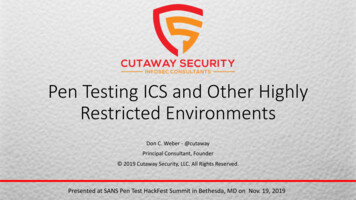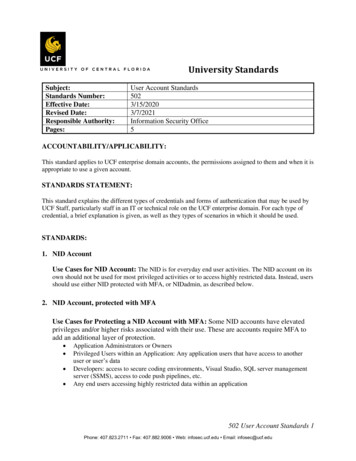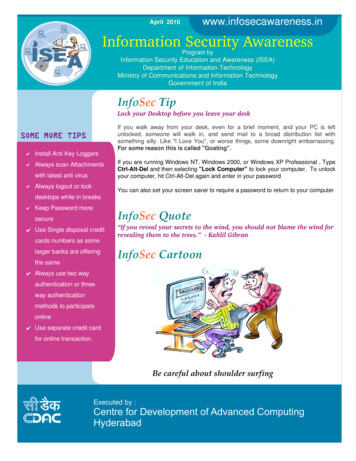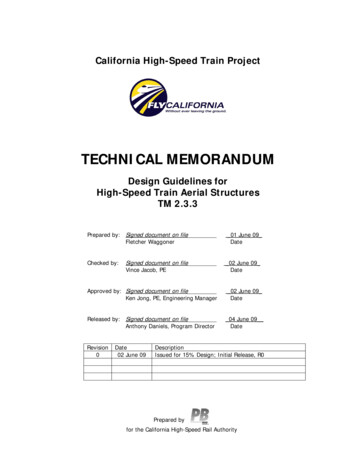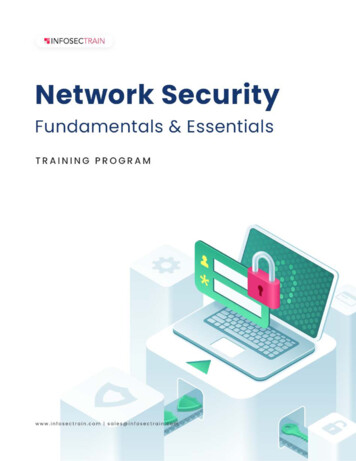
Transcription
Course OverviewNetwork Security is one of the most significant parts of any informationsecurity process due to overreliance on various verticals for business andpersonal communication. Companies of all scales and sizes should haveproper strategies and mitigation processes to secure their networks toensure optimum digital security and compliance. Although there are nonetworks that are completely secured from cyber threats, an efficientand reliable network security system can ensure that essential security ismaintained throughout the network system of the business.This course is designed to help you build your fundamental basics ofunderstanding the working of Networks and their various components.The course extensively covers a wide range of concepts like Networks andNetworking basics, IP Addressing, threats targeting Network security,network security fundamentals, routers, firewalls, malware, and muchmore!This course will also help you build your base as a cybersecurityprofessional as Network security is a significant part of the same. Thisnetwork security training program will help you identify and mitigatevarious types of Network Security threats and attacks that plagueNetwork security systems like Sniffing, DoS & DDoS attacks, Fraggle andSmurf attacks, DNS poisoning, etc. Take advantage of this best networksecurity training from InfoSecTrain and help yourself jumpstart a lucrativeCybersecurity career.www.infosectrain.com sales@infosectrain.com01
Target Audience Anyone who is interested to explore network security in-depth and gainessential skills for their cybersecurity career. IT security enthusiasts looking to build a career in the same Analysts and Junior engineers looking to build a career in cybersecurityPrerequisites Basic knowledge of Network and Networking concepts like TCPs, DNS, IPs,Ports, etc. Linux Basics/ fundamentals and scripting in Linux OS Computing fundamentals and Internet working methodology Computer Science fundamentals/ backgroundwww.infosectrain.com sales@infosectrain.com02
Why Infosec Train?Flexible ScheduleCertified &Experienced InstructorPost TrainingSupportAccess to therecordedsessionsTailor Made Trainingwww.infosectrain.com sales@infosectrain.com4 hrs/day inWeekend/Weekday03
Course ContentNetwork Security Introduction Module What is Network Security Fundamentals of Networks IP Addressing Threats that impact network security & their types What are Cyber Controls Introducing ISO-27001 & PCI-DSSUnderstanding of Router & Hands-on practice onVulnerability Scanning Understanding of Router & End Points Network Discovery using hping3, arp-scan, Angry IP Scanner Finding Open Ports using Nmap Scanning for Vulnerabilities Vulnerability Scanners including OpenVAS, Nessus, NmapFirewalls & its Types Understanding Firewall Host Based Firewall Network Based Firewall Linux – iptables & Configurations Windows Firewall Windows Firewall Control (WFC) Network Based Firewall - pfSense Configuring & Detection using Snortwww.infosectrain.com sales@infosectrain.com04
Network Attacks - The Reason for Network Security Introduction to network-based attacks, now and then. Practical Demonstrations – Man in the middle, SSL Stripping, ARP &DNS Spoofing Sniffing concepts DoS & DDoS Attack Fraggle and Smurf Attack DNS Poisoning & Ping of Death Attack Firewalking Perform Privilege Escalation to Gain Higher Privileges - Practical Maintain Remote Access and Hide Malicious Activities Reconnaissance Introduction to IoT & ICS Challenges of IoT Coding Errors (Buffer Overflow) Lack Of Security & Privacy Extensive use of clear text protocols & unnecessary open ports. IoT Security Problems OWASP Top 10 IoT Threatswww.infosectrain.com sales@infosectrain.com05
Malwares Introducing Malwares Types of Malwares – Virus, Keyloggers, Worms, Trojan, Rootkits,Spyware, Adware Functionalities of Malwares Ransomware – Myths/Facts Working of Ransomwares Ransomware Deliveries Prevention against Ransomwares (Corporate Best Practices)Understanding of Wireless and Wi-fi Security What is a Wireless Network? Wi-Fi Standards Wi-Fi Encryptions – WEP, WPA, WPA2, WPA3 Wi-Fi Weaknesses Wi-Fi Attack – Practical Wireless Security Fundamentals of LiFi Zigbee for IoTNetwork Monitoring – Fundamentals Introduction to Wireshark Using filters of Wireshark Network Packet Analysis - Practical Detecting malwares using Wireshark - Practicalwww.infosectrain.com sales@infosectrain.com06
Browser Security - Learning tools and their usage Minimize Browser Attacking Surface Browser Hacking - Practical Browser Hardening - Firefox Firefox Security, Privacy & Tracking HTTP Filters, ad and blockers Disconnect, Ghostery, Request Policy - HTTP Filters, ad and blockers ABP, Privacy badger - HTTP Filters, ad and blockers uMatrix and others - HTTP Filters, ad and blockers History, Cookies Fingerprinting BrowserLearning Authentication & Why it is Important Understanding Authentication Multi-Factor Authentication (MFA) Something You Know Something You Have Something You Are Choosing a Method of Multi-Factor Authentication MFA - Strength & Weakness Password Cracking Password Managers - KeePass Strong Password Creation & Necessitywww.infosectrain.com sales@infosectrain.com07
A Cryptography Primer Cryptography description Symmetric/Asymmetric Cryptography Hashing Encoding/Decoding Digital Signatures PKI – Practicalwww.infosectrain.com sales@infosectrain.com08
www.infosectrain.com sales@infosectrain.com
Scanning for Vulnerabilities Vulnerability Scanners including OpenVAS, Nessus, Nmap www.infosectrain.com sales@infosectrain.com 04 Course Content Firewalls & its Types . (Corporate Best Practices) Malwares What is a Wireless Network? Wi-Fi Standards Wi-Fi Encryptions - WEP, WPA, WPA2, WPA3
